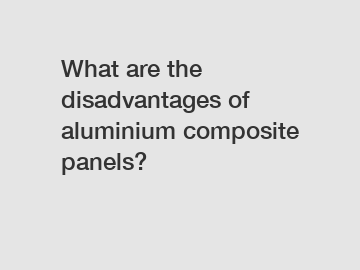What are the disadvantages of aluminium composite panels?
What are the disadvantages of aluminium composite panels?
Aluminium composite panels (ACP) have gained popularity in the construction industry due to their versatility, durability, and aesthetic appeal. Composed of two aluminium sheets bonded to a core material, ACPs provide a lightweight yet robust solution for cladding, signage, and interiors. However, like any building material, ACPs also have their drawbacks. In this article, we will explore some of the disadvantages associated with aluminium composite panels.
Limited Fire Resistance:

One of the primary disadvantages of aluminium composite panels is their limited fire resistance. While the aluminium sheets on the exterior are fire-resistant, the core material, often made of polyethylene, is highly flammable. In case of a fire, the core material can release toxic gases and contribute to the spread of flames. This drawback makes ACPs unsuitable for certain applications, especially in high-rise buildings or areas with stringent fire safety regulations.
Susceptibility to Denting:
Due to their lightweight nature, aluminium composite panels are more susceptible to denting and damage compared to other cladding materials. Although aluminium itself is a durable metal, ACPs consist of a thin layer of aluminium bonded to the core material, making them more prone to dents caused by impact or extreme weather conditions. This drawback can be significant particularly in areas prone to hailstorms or high winds, compromising the aesthetics and structural integrity of the panels.
Limited Color Retention:
Another disadvantage of aluminium composite panels is their limited color retention, especially when exposed to harsh weather conditions or UV radiation. Over time, the colors of ACPs can fade or change, resulting in a dull appearance. This drawback may be problematic in applications where the panels are exposed to direct sunlight or extreme weather conditions, such as external cladding or outdoor signage. Regular maintenance and the use of protective coatings can help mitigate color fading to some extent, but it remains a potential drawback.
Difficulties in Recycling:
ACP recycling poses challenges due to the difficulties in separating the different materials used in their construction. The process of separating the aluminium sheets from the core materials can be time-consuming, expensive, and often requires specialized recycling facilities. This drawback poses an environmental concern, as ACPs are not easily recyclable and may end up in landfills if proper recycling facilities are not available in the vicinity.
Lack of Sound Insulation:
Aluminium composite panels have limited sound insulation properties compared to other building materials. The thin aluminium sheets and the core material do not provide significant soundproofing, allowing noise to penetrate through the panels. This drawback can be crucial in applications where sound insulation is a priority, such as in recording studios or buildings located near high-traffic areas. Additional soundproofing measures or alternative cladding materials may be necessary to compensate for this limitation.
Conclusion:
While aluminium composite panels offer numerous benefits, it is important to consider their disadvantages before selecting them as a building material. Limited fire resistance, susceptibility to denting, color retention issues, recycling difficulties, and lack of sound insulation are notable drawbacks associated with ACPs. However, with proper consideration of these limitations and appropriate design adaptations, ACPs can still be a viable solution for various architectural projects.
If you are looking for further information on aluminium composite panels or need assistance with your project, please feel free to contact us.
Contact us to explore the best options for your building needs.
If you are looking for more details, kindly visit customized color coated aluminum coil, coated aluminum coil suppliers, coil coated finishes.

Comments
0